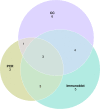Biological Diagnosis of Ocular Toxoplasmosis: a Nine-Year Retrospective Observational Study
- PMID: 31554726
- PMCID: PMC6763772
- DOI: 10.1128/mSphere.00636-19
Biological Diagnosis of Ocular Toxoplasmosis: a Nine-Year Retrospective Observational Study
Abstract
Ocular toxoplasmosis (OT), i.e., the ocular manifestation of Toxoplasma gondii infection, is one of the leading causes of posterior uveitis. While ocular lesions are often typical, atypical forms often require biological confirmation of the diagnosis. Our study sought to review the biological OT diagnoses made in our laboratory to further assess the role of each test in the diagnostic procedure. All ocular samples sent to our laboratory over the last 9 years for OT diagnosis were included. These samples were analyzed using T. gondii PCR and antibody detection by means of immunoblotting and Candolfi coefficient (CC) determinations, either alone or in combination. Since serum analysis is required to interpret both the CC and immunoblotting, blood serology for T. gondii was also performed in most cases. Of the 249 samples analyzed, 80 (32.1%; 95% confidence interval [95%CI], 26.3 to 37.9) were positive for OT. Of these 80 cases, 52/80 (65.0%; 54.6 to 74.5) displayed a positive PCR, 15/80 (18.8%; 10.2 to 27.3) a positive CC, and 33/80 (41.3%; 95%CI, 30.5 to 52.0) a positive immunoblot result. Overall, 63 of the 80 OT diagnoses (78.8%; 95%CI, 69.8 to 87.7) were made on the basis of a single positive test result. Our study results remind us that current biological diagnostic tools for OT must be employed in combination to obtain an optimal diagnosis based on the precious ocular fluids sampled by ophthalmologists. Clinicobiological studies that are focused on correlating the performances of the different tests with clinical features are critically needed to improve our understanding of the pathophysiology and diagnosis of OT.IMPORTANCE Ocular toxoplasmosis (OT), a parasitic infection of the eye, is considered to be the most important infectious cause of posterior uveitis worldwide. Its prevalence is particularly high in South America, where aggressive Toxoplasma gondii strains are responsible for more-severe presentations. The particular pathophysiology of this infection leads, from recurrence to recurrence, to potentially severe vision impairment. The diagnosis of this infection is usually exclusively based on the clinical examination. However, the symptoms may be misleading and are not always sufficient to confirm a diagnosis of OT. In such cases, biological tests performed by means of several techniques on blood and ocular samples may facilitate the diagnosis. In this study, we analyzed the tests that were performed in our laboratory over a 9-year period every time OT was suspected. Our report highlights that the quality of ocular sampling by ophthalmologists and combinations of several techniques are critical for a reliable biological OT diagnosis.
Keywords: Toxoplasma gondii; diagnosis; diagnostics; infectious disease; ocular immunology; ocular toxoplasmosis; ophthalmology; parasite; parasitology; retinochoroiditis.
Copyright © 2019 Greigert et al.
Figures



References
Publication types
MeSH terms
Substances
LinkOut - more resources
Full Text Sources
